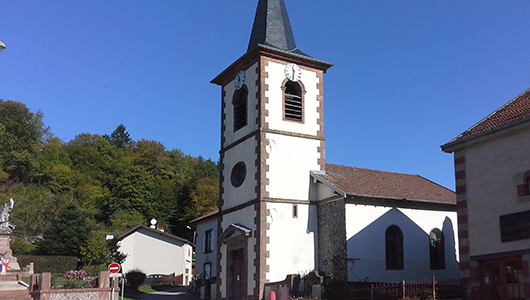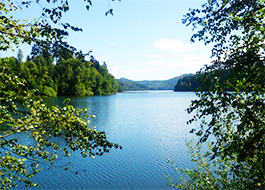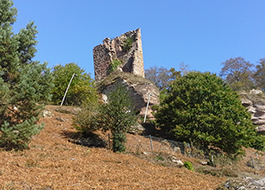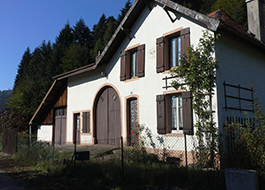Pierre Percée
Durée visite : 90 minutes
Moyen : Pédestre
Le château de Pierre-Percée qui a donné son nom au village, bâti au Moyen Âge, ne subsiste qu’à l’état de ruines sur un site exceptionnel, constitué par un éperon rocheux. La basse-cour du château s’étendait sur le côté nord-ouest, le moins abrupt de la pente. La mention la plus ancienne d’un château à Pierre-Percée vient d’une chronique de 1140. Elle concerne Albertum de Longuicastro, un noble qui aurait vécu au milieu du XIe siècle. Longuicastro serait la latinisation de Langenstein ou la longue pierre, sur laquelle est construit le château, castro équivalent en vieil allemand à Stein qui désigne un château. Albertum est un cadet de la famille des comtes d’Alsace. Nommé duc de Lorraine par l’empereur Henri III, c’est probablement lui qui construit le château dont il prend le nom. En 1048, il est tué par Godefroy II le Barbu, qui voulait récupérer son duché, à la bataille de Thuin. Henri III donne alors le duché au frère d’Albertum, Gérard Ier de Lorraine.
The castle of Pierre-Percée which gave its name to the village, built in the Middle Ages, remains only in the state of ruins on an exceptional site, constituted by a rocky outcrop. The chateau’s courtyard ran on the north-west side, the steepest side of the slope. The earliest mention of a castle in Pierre-Percée comes from a chronicle of 1140. It concerns Albertum de Longuicastro, a noble who would have lived in the middle of the eleventh century. Longuicastro would be the Latinization of Langenstein or the long stone, on which is built the castle, castro equivalent in old German to Stein which designates a castle. Albertum is a junior of the family of the counts of Alsace. Named Duke of Lorraine by the Emperor Henry III, it is probably he who built the castle which he takes the name. In 1048, he was killed by Godefroy II the Bearded, who wanted to recover his duchy, at the Battle of Thuin. Henry III then gives the duchy to Albertum’s brother, Gerard I of Lorraine.
Das Schloss von Pierre-Percée, das dem im Mittelalter errichteten Dorf seinen Namen gab, ist nur noch Ruinen an einem außergewöhnlichen Ort, der aus einem Felsvorsprung besteht. Der Hof des Schlosses verlief auf der Nordwestseite, der steilsten Seite des Abhangs. Die erste Erwähnung eines Schlosses in Pierre-Percée stammt aus einer Chronik von 1140. Es handelt sich um Albertum de Longuicastro, einen Adligen, der in der Mitte des 11. Jahrhunderts gelebt hätte. Longuicastro wäre die Latinisierung von Langenstein oder der lange Stein, auf dem die Burg gebaut ist, Castro entspricht in altdeutschem Stein, der eine Burg bezeichnet. Albertum ist ein Nachwuchs der Familie der Grafen des Elsass. Von Kaiser Heinrich III. Zum Herzog von Lothringen ernannt, baute er wahrscheinlich das Schloss, das er den Namen verdankt. 1048 wurde er von Godefroy II., Dem Bärtigen, getötet, der sein Herzogtum in der Schlacht von Thuin zurückgewinnen wollte. Heinrich III. Übergibt das Herzogtum an Albertums Bruder, Gerard I. von Lothringen.

De gueules semé de croix recroisetées au pied fiché d’argent à deux saumons adossés de même brochant sur le tout.
Ce sont les armes des princes de Salm qui ont construit le château. Ce château qui domine Pierre Percée s’appelait d’abord Langstein et changea de nom lorsque Agnès de Langstein, épouse du Comte de Salm Herman, fit creuser un puits dans la roche. Ce château, dont une tour subsiste encore de nos jours, passait pour l’un des plus forts de la région.
These are the arms of the princes of Salm who built the castle. This castle which dominates Pierre Percée was first called Langstein and changed its name when Agnès de Langstein, wife of the Count of Salm Herman, had a well dug in the rock. This castle, of which a tower still remains today, was considered one of the strongest in the region.
Dies sind die Arme der Fürsten von Salm, die die Burg gebaut haben. Diese Burg, die Pierre Percée dominiert, hieß zuerst Langstein und änderte ihren Namen, als Agnès de Langstein, die Frau des Grafen von Salm Herman, einen Brunnen in den Felsen gegraben hatte. Diese Burg, von der heute noch ein Turm erhalten ist, galt als eine der stärksten in der Region.
Les points de visites
.
Pierre-Percée Lake is the third largest artificial lake in Lorraine. It has 304 hectares of surface and 32 kilometers of circumference. Lake Madine, with 1,100 ha, and Etang du Stock with 700 ha, exceed it. However, it is the largest reservoir of water in Lorraine with 62 million m3 of water. Its maximum depth is around 80 meters. It is quite unusual by its shape. The flooded area is composed of several valleys, giving the lake the shape of a maple leaf. Lake water is discharged into the Plain then into the Meurthe when the flow of the Moselle is too low. It compensates for the water withdrawal from the Cattenom nuclear power plant. And thus guarantees a minimum flow of the Moselle in Luxembourg during low water periods. At 78 meters high, the dam is partly composed of trapp, the hardest rock in Europe, which does not freeze and is not permeable. The heart of the dam is composed of clay and sandstone. The width is 355 meters at the base and 8 meters at the crest, 330 meters long. Mallard, coot, crested grebe and gray heron make up the local fauna. The lake is also known for fishing, there are several species of fish: pike, perch, roach, tench and carp. They introduced coregonids, fish from deep lakes.
Der Pierre-Percée-See ist der drittgrößte künstliche See in Lothringen. Es hat 304 Hektar Fläche und 32 Kilometer Umfang. Der See Madine mit 1.100 ha und der Etang du Stock mit 700 ha übertreffen ihn. Mit 62 Millionen m3 Wasser ist es jedoch das größte Wasserreservoir in Lothringen. Die maximale Tiefe beträgt etwa 80 Meter. Es ist durch seine Form ziemlich ungewöhnlich. Das überflutete Gebiet besteht aus mehreren Tälern, die dem See die Form eines Ahornblattes verleihen. Seewasser wird in die Tiefebene geleitet und dann in die Meurthe, wenn der Fluss der Mosel zu gering ist. Sie kompensiert die Wasserentnahme aus dem Kernkraftwerk Cattenom. Und garantiert so einen minimalen Fluss der Mosel in Luxemburg bei Niedrigwasserperioden. Bei einer Höhe von 78 Metern besteht der Damm teilweise aus Trapp, dem härtesten Gestein Europas, der nicht einfriert und nicht durchlässig ist. Das Herz des Damms besteht aus Lehm und Sandstein. Die Breite beträgt 355 Meter an der Basis und 8 Meter am Kamm, 330 Meter lang. Stockente, Rotwild, Haubentaucher und Graureiher bilden die örtliche Fauna. Der See ist auch für das Angeln bekannt, es gibt verschiedene Fischarten: Hecht, Barsch, Plötze, Schleie und Karpfen. Sie führten Koregoniden ein, Fische aus tiefen Seen.
.
.
Le château date du XIe siècle. Il est construit par Albertum ou Adalbert, duc de Lorraine, de la famille d’Alsace. Avant 1138, un puits de quelque 30 mètres de profondeur est creusé, à l’aplomb sud-ouest du rocher. Seule la partie supérieure du puits est encore visible. Son diamètre est de 2,20 mètres. La réalisation de ce travail, exceptionnel pour l’époque, n’a pas manqué de frapper les esprits. On désigna ainsi la forteresse sous le nom de Petrae Perforatae en latin, Piereperciée en vieux français.Le château passe aux comtes de Salm. Une chapelle y est attestée. Le château n’est pas le logement principal des comtes. Ces derniers résident principalement dans les villes et à la cour ducale. Les châteaux éloignés sont laissés à des fonctionnaires : cellérier, capitaine, prévôt. Le château sert également de caution lorsque le comte doit réaliser des emprunts. Vers 1550, des travaux concernent la basse-cour, les toitures, la citerne, le pont-levis, la tour de guet, les deux corps de garde. Une canonnière est aménagée près du pont-levis. Les arquebuses sont révisées par un maître arquebusier de Badonviller. En 1636, le château et le hameau établi à ses pieds sont détruits. C’est l’oeuvre des troupes conduites par Bernard de Saxe-Weimar contre les troupes impériales. Pierre-Percée n’a plus été reconstruit, et ses pierres ont été utilisées comme matériaux de construction. Du château ne subsiste de nos jours que quelques modestes murs à l’extrémité ouest-sud-ouest. On y voit une tour-donjon de section carrée de 8 m x 8 m s’élevant encore jusqu’à 13 mètres. Réalisée en bel appareil, percé d’un fenestron de style roman, elle daterait du XIIe siècle.
The castle dates from the 11th century. It is built by Albertum or Adalbert, Duke of Lorraine, of the Alsace family. Before 1138, a well about 30 meters deep is dug, in the southwest southwest of the rock. Only the upper part of the well is still visible. Its diameter is 2.20 meters. The realization of this work, exceptional for the time, did not fail to hit the spirits. The fortress was thus designated by the name of Petrae Perforatae in Latin, pierced in Old French. The castle passes to the Counts of Salm. A chapel is attested. The castle is not the main home of the counts. The latter live mainly in the cities and in the ducal court. The distant castles are left to officials: cellarer, captain, provost. The castle also serves as bail when the count must make loans. Around 1550, works concern the barnyard, the roofs, the cistern, the drawbridge, the watch tower, the two guard-houses. A gunboat is located near the drawbridge. The arquebuses are revised by a harquebusier master of Badonviller. In 1636, the castle and the hamlet at his feet were destroyed. It is the work of the troops led by Bernard of Saxe-Weimar against the imperial troops. Pierre-Percée was no longer rebuilt, and its stones were used as building materials. From the castle only a few walls remain today at the west-south-west end. There is a tower-donjon square section of 8 m x 8 m still rising up to 13 meters. Made in beautiful apparatus, pierced with a fenestron of Romanesque style, it dates from the 12th century.
Die Burg stammt aus dem 11. Jahrhundert. Es wurde von Albertum oder Adalbert, Herzog von Lothringen, der elsässischen Familie gebaut. Vor 1138 wurde im Südwesten des Felsens ein etwa 30 Meter tiefer Brunnen gegraben. Nur der obere Teil des Brunnens ist noch sichtbar. Sein Durchmesser beträgt 2,20 Meter. Die für diese Zeit außergewöhnliche Verwirklichung dieser Arbeit kam nicht zu kurz. Die Festung wurde auf diese Weise mit dem Namen Petrae Perforatae im lateinischen Stil bezeichnet und ist in Altfranzösisch durchbohrt. Die Burg geht an die Grafen von Salm über. Eine Kapelle ist attestiert. Das Schloss ist nicht die Hauptwohnung der Grafen. Letztere leben hauptsächlich in den Städten und am Herzoglichen Hof. Die weit entfernten Burgen sind Beamten überlassen: Kellermeister, Kapitän, Vorsteher. Das Schloss dient auch als Kaution, wenn der Graf Kredite gewähren muss. Um 1550 betreffen die Arbeiten den Scheunenhof, die Dächer, die Zisterne, die Zugbrücke, den Wachturm und die beiden Wachhäuser. Ein Kanonenboot befindet sich in der Nähe der Zugbrücke. Die Arquebuses werden von einem Harquebusier-Meister von Badonviller überarbeitet. Im Jahre 1636 wurden die Burg und der Weiler zu seinen Füßen zerstört. Es ist die Arbeit der von Bernhard von Sachsen-Weimar geführten Truppen gegen die kaiserlichen Truppen. Pierre-Percée wurde nicht mehr umgebaut und seine Steine wurden als Baumaterial verwendet. Von der Burg sind heute nur wenige Mauern am West-Südwest-Ende erhalten. Es gibt einen Turm-Donjon-Platzabschnitt von 8 x 8 m, der noch bis zu 13 Meter hoch ist. Hergestellt in einem wunderschönen Apparat, der mit einem Fenestron im romanischen Stil durchbohrt wurde, stammt es aus dem 12. Jahrhundert.
.
L’association Guerre en Vosges s’intéresse à l’étude de tous les aspects des conflits qui ont eu pour cadre les Vosges, notamment à la guerre de montagne en 1914-1918. Grâce à la Communauté de Communes de la Vallée de la Plaine, qui a acquis une importante collection d’objets militaires, et la commune de Pierre Percée qui a mis à disposition des locaux, le Centre d’Interprétation 1914-1918 a pu être créé. Son animation a été confiée à l’association. Le musée présente une sélection de pièces caractéristiques de la Grande Guerre. Mais il présente surtout l’histoire particulière du secteur. Des objets et de panneaux très illustrés y contribuent. Il a été choisi de montrer plusieurs mannequins en situation, dans une tranchée, un abri. Suivant l’intérêt et l’âge du public, une partie importante de la collection peut être manipulée par les visiteurs. On peut sentir la texture d’une capote, le poids d’un sac ou d’une arme.
Jacques Bourquin, Président de l’Association – tél: 03 29 41 56 82 – Les visites sont gratuites
The Association Guerre en Vosges is interested in the study of all aspects of the conflicts that took place in the Vosges, in particular the mountain war in 1914-1918. Thanks to the Community of Communes of the Vallée de la Plaine, which acquired a large collection of military objects, and the municipality of Pierre Percée which made premises available, the 1914-1918 Interpretation Center was created. . Its animation has been entrusted to the association. The museum presents a selection of pieces characteristic of the Great War. But above all, it presents the particular history of the sector. Very illustrated objects and panels contribute to this. It was chosen to show several mannequins in situation, in a trench, a shelter. Depending on the interest and age of the public, an important part of the collection may be handled by visitors. You can feel the texture of a hood, the weight of a bag or a weapon.
Jacques Bourquin, President of the Association – tel: 03 29 41 56 82 – Visits are free of charge
Der Verein Guerre en Vosges interessiert sich für die Untersuchung aller Aspekte der Konflikte in den Vogesen, insbesondere des Bergkrieges von 1914-1918. Dank der Gemeinde der Gemeinden des Tals der Ebene, die eine große Sammlung militärischer Objekte erwarb, und der Gemeinde Pierre Percée, die Räumlichkeiten zur Verfügung stellte, wurde das Interpretationszentrum 1914-1918 gegründet. . Die Animation wurde dem Verein anvertraut. Das Museum präsentiert eine Auswahl von Stücken, die für den Ersten Weltkrieg charakteristisch sind. Vor allem aber präsentiert es die besondere Geschichte des Sektors. Sehr illustrierte Objekte und Tafeln tragen dazu bei. Es wurde ausgewählt, um mehrere Mannequins in einer Situation zu zeigen, in einem Graben, einem Unterschlupf. Je nach Interesse und Alter der Öffentlichkeit kann ein erheblicher Teil der Sammlung von Besuchern manipuliert werden. Sie können die Textur einer Kapuze, das Gewicht einer Tasche oder einer Waffe spüren.
Jacques Bourquin, Präsident des Vereins – Tel .: 03 29 41 56 82 – Besuche sind kostenlos
.
La présence agricole est attestée au 2e siècle avant notre ère et à l’époque gallo-romaine. Les vagues de christianisation se succèdent à partir du 7e siècle. Ces dernières suscitèrent un développement du secteur avec l’implantation des abbayes bénédictines. Quel que soit leur statut, les abbayes étaient propriétaires des terres avoisinantes qui furent défrichées. Gagnée sur la forêt, une première vague de défrichage voit apparaître des granges au milieu de prairies de fauche. A la fin du 16e siècle commença la seconde vague de défrichement. Elle s’étendit jusqu’au début du 18e siècle. Elle fut marquée par un net recul de la forêt. Ceci explique un habitat rural particulièrement dispersé dans la zone montagne des Vosges. Aussi une pratique agraire individuelle s’affirme. Elle contraste fortement avec les usages communautaires de Lorraine. Le bâti rural peut être daté du 18e siècle avec un pic spécifique pour les années 1720. L’essor démographique se marqua par la construction de fermes à double logis en profondeur, ou par l’agrandissement des logis anciens. On ajouta une ou plusieurs travées permettant d’abriter des familles supplémentaires. Le retour à une certaine aisance se marqua par la présence d’un décor, par la création de cheminée de type urbain, par la pose de lambris de hauteur dans les pièces. L’activité pastorale constituait, et constitue toujours, un volet essentiel de l’activité agricole de la Montagne vosgienne. Mais la pluri-activité est importante d’où la présente d’un atelier dans les fermes. Au 19e siècle, le paysan pluri-actif est ouvrier textile.
The agricultural presence is attested in the 2nd century BC and the Gallo-Roman era. The waves of Christianization succeed one another from the 7th century. These led to a development of the sector with the establishment of Benedictine abbeys. Regardless of their status, the abbeys owned the surrounding land which was cleared. Winning on the forest, a first wave of clearing sees barns appear in the middle of hay meadows. At the end of the 16th century began the second wave of clearing. It extended until the beginning of the 18th century. It was marked by a clear retreat of the forest. This explains a particularly scattered rural habitat in the Vosges mountain area. Also an individual agrarian practice asserts itself. It contrasts sharply with the community uses of Lorraine. The rural building can be dated from the 18th century with a specific peak for the 1720s. The population boom was marked by the construction of double-deep farmhouses, or by the expansion of old houses. One or more bays were added to house additional families. The return to a certain ease was marked by the presence of a decoration, by the creation of chimney of urban type, by the installation of paneling of height in the rooms. Pastoral activity was, and still is, an essential part of the agricultural activity of the Montagne Vosgienne. But the pluri-activity is important where there is a workshop on farms. In the 19th century, the multi-active peasant is a textile worker.
Die landwirtschaftliche Präsenz wird im 2. Jahrhundert v. Chr. Und in der gallo-römischen Zeit nachgewiesen. Die Christianisierungswellen folgen ab dem 7. Jahrhundert aufeinander. Diese führten zu einer Entwicklung des Sektors mit der Gründung von Benediktinerabteien. Unabhängig von ihrem Status besaßen die Abteien das umliegende Land, das geräumt wurde. Eine erste Welle der Lichtung, die im Wald siegte, sieht Scheunen in der Mitte von Heuwiesen. Am Ende des 16. Jahrhunderts begann die zweite Lichtungswelle. Es dehnte sich bis zum Beginn des 18. Jahrhunderts aus. Es war durch einen klaren Rückzug des Waldes gekennzeichnet. Dies erklärt einen besonders zerstreuten ländlichen Lebensraum in den Vogesen. Auch eine individuelle landwirtschaftliche Praxis behauptet sich. Es steht im krassen Gegensatz zu den gemeinschaftlichen Nutzungen von Lothringen. Das ländliche Gebäude kann aus dem 18. Jahrhundert mit einem spezifischen Höhepunkt für die 1720er Jahre datiert werden: Der Bevölkerungsboom wurde durch den Bau von doppelt tiefen Bauernhäusern oder durch die Erweiterung alter Häuser geprägt. Eine oder mehrere Buchten wurden hinzugefügt, um weitere Familien aufzunehmen. Die Rückkehr zu einer gewissen Leichtigkeit war gekennzeichnet durch das Vorhandensein einer Dekoration, durch die Schaffung eines Schornsteins vom städtischen Typ, durch die Installation einer Höhenverkleidung in den Räumen. Die pastorale Tätigkeit war und ist ein wesentlicher Bestandteil der landwirtschaftlichen Tätigkeit der Montagne Vosgienne. Die Pluri-Aktivität ist jedoch wichtig, wenn auf landwirtschaftlichen Betrieben ein Workshop stattfindet. Im 19. Jahrhundert ist der multiaktive Bauer Textilarbeiter.









